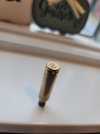rammac
Well-Known Member
Try rubbing a little case lube or light oil on the body and firing one. If there is excessive clearance between the case head and bolt face the primer will protrude back into the bolt face before the case slides back once released from the chamber walls as the pressure drops a little. Lubing the case slightly will allow the case to thrust backward to the bolt along with the primer then expand completely to the chamber walls. If excess clearance (from undersized brass ie- shoulder too far back) is the culprit that fired case should show no primer flattening. If that be the case then readjust your sizing die for less shoulder 'bump'.
Why not just turn the resizing die counterclockwise a 1/8th turn or so (reducing the shoulder bump) and see if the primers aren't as flat? That's safer and has less potential for other, more dangerous problems when you lube the case.
Personally, I think you're worried about nothing. As said earlier, the primer is still round, the gap between the primer cup and the case pocket is still there, and there is no cratering, so I'd say that you aren't seeing too high of pressure, just the effect of too much shoulder bump.

